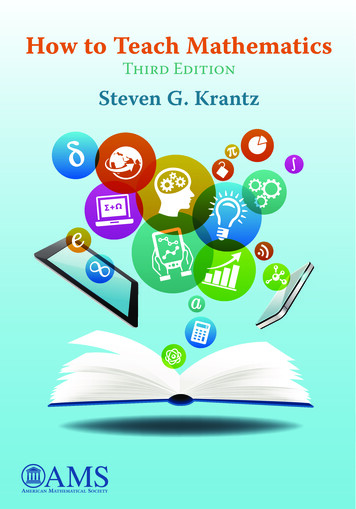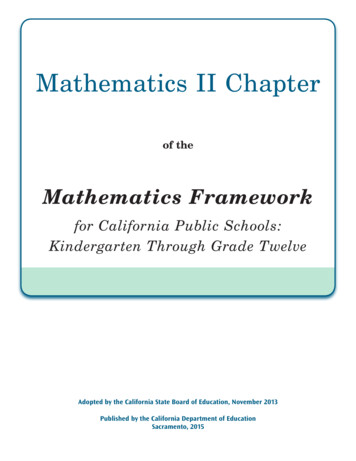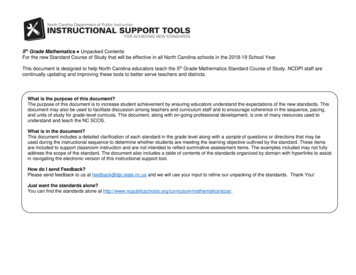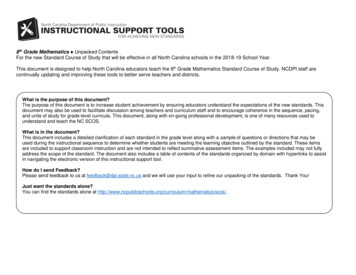
Transcription
How to Teach MathematicsThird EditionSteven G. Krantz
How to Teach MathematicsThird Edition
http://dx.doi.org/10.1090/mbk/089How to Teach MathematicsThird EditionSteven G. KrantzProvidence, Rhode Island
2010 Mathematics Subject Classification. Primary 97D40, 97Q60, 97U20, 97U50, 97U70.Cover 4 author photograph courtesy of Steven G. Krantz.For additional information and updates on this book, visitwww.ams.org/bookpages/mbk-89Library of Congress Cataloging-in-Publication DataKrantz, Steven G. (Steven George), 1951How to teach mathematics / Steven G. Krantz. –Third edition.pages cm.Includes bibliographical references and index.ISBN 978-1-4704-2552-4 (alk. paper)1. Mathematics–Study and teaching.I. Title.QA11.K776 2015510.71 1—dc232015021663Copying and reprinting. Individual readers of this publication, and nonprofit librariesacting for them, are permitted to make fair use of the material, such as to copy select pages foruse in teaching or research. Permission is granted to quote brief passages from this publication inreviews, provided the customary acknowledgment of the source is given.Republication, systematic copying, or multiple reproduction of any material in this publicationis permitted only under license from the American Mathematical Society. Permissions to reuseportions of AMS publication content are handled by Copyright Clearance Center’s RightsLink service. For more information, please visit: http://www.ams.org/rightslink.Send requests for translation rights and licensed reprints to reprint-permission@ams.org.Excluded from these provisions is material for which the author holds copyright. In such cases,requests for permission to reuse or reprint material should be addressed directly to the author(s).Copyright ownership is indicated on the copyright page, or on the lower right-hand corner of thefirst page of each article within proceedings volumes.c 2015 by the American Mathematical Society. All rights reserved. Printed in the United States of America. The paper used in this book is acid-free and falls within the guidelines established to ensure permanence and durability.Visit the AMS home page at http://www.ams.org/10 9 8 7 6 5 4 3 2 120 19 18 17 16 15
To Robert L. Borrelli, teacher and friend.
ContentsPreface to the Third EditionixPreface to the Second EditionxiPreface to the First EditionxviiChapter 1. Guiding Principles1.0. Chapter Overview1.1. Respect1.2. Prepare1.3. Speak Up1.4. Lectures1.5. Questions1.6. Time1.7. Applications1.8. The Moore Method11135610141620Chapter 2. Practical Matters2.0. Chapter Overview2.1. Voice2.2. Eye Contact2.3. Blackboard Technique2.4. Homework2.5. Office Hours2.6. Designing a Course2.7. Handouts2.8. Teaching Evaluations2.9. Exams2.10. Grading2.11. The Syllabus (and the Course Diary)2.12. Choosing a Textbook2.13. Large Lectures2.14. Problem Sessions, Review Sessions, andHelp Sessions2.15. On Being a TA2.16. Tutors232323252630323536374349525558Chapter 3. Spiritual Matters3.0. Chapter Overview3.1. Breaking the Ice3.2. Math Anxiety69696970vii636566
viiiCONTENTS3.3.3.4.3.5.3.6.3.7.3.8.Inductive vs. Deductive Method71Who Is My Audience?74Mentors and Neophytes76Teaching Reform78STEM83How to Ask, How to Answer84APPENDIX to 3.8: Suggestions for Encouraging Class Participation 863.9. Inquiry-Based Learning893.10. The Art of Discourse893.11. Do I Have to Teach Calculus Again?91Chapter 4. The Electronic World4.0. Chapter Overview4.1. Teaching with the Internet4.2. Online Learning vs. Classroom Learning4.3. MOOCs4.4. The Khan Academy4.5. The Flipped Classroom4.6. Computer Labs4.7. Clickers4.8. Homework Solutions on the Internet4.9. Online Software4.10. The Course Web Page4.11. Social Media4.12. SmartBoards4.13. Reference URLs93939394959898100101102104105106107108Chapter 5. Difficult Matters5.0. Chapter Overview5.1. Non-Native English Speakers5.2. Late Work5.3. Cheating5.4. Incompletes5.5. Discipline5.6. Mistakes in Class5.7. Advice and Consent5.8. Sexism, Racism, Misogyny, and Related Problems5.9. Begging and Pleading111111111113113115116119120121124Chapter 6. A New Beginning6.0. Chapter Overview6.1. The Role of the University Professor6.2. Closing Thoughts127127127128Bibliography131Index137
Preface to the Third EditionIt has been fifteen years since the appearance of the Second Edition of this book.A lot has happened since then. The teaching reform movement has become a factof life. Many of us have had occasion to rethink how and why we teach. Many of ushave taken time to learn about the myriad of new (often OnLine) teaching devicesthat are available today. Among these are MOOCs (massive open online courses), theKhan Academy, flipped classrooms, clickers, smartboards, and the list goes on atsome length.Our goal with this new edition is to present a streamlined approach to ourteaching philosophy. Many found the First Edition of this book to be attractivebecause it was only 80 pages. The Second Edition was 300 pages. It offered muchmore, but was correspondingly more cumbersome. One could easily read the FirstEdition during a long lunch hour. The Second Edition represented more of aninvestment of time and effort.This Third Edition will be a slimmed-down version of the key ideas in thefirst two editions. We still want to emphasize the nuts and bolts of good teaching:prepare, respect your students, be flexible, be knowledgeable, be of good spirit,be a role model, and prepare some more. We have eliminated several sectionswhich, from today’s perspective, appear to be redundant. And we have revised andmodified several other sections.The other goal of this new version is to explore many of the new OnLine learningtools that are now available. Some of these will make little sense to the traditionallytrained instructor. Others will be fascinating, and will give us new ideas of thingsto try.One of the innovations in the Second Edition was the inclusion of ten Appendices by other mathematicians with strong views about mathematics teaching.Some of these scholars agreed with me, and some of them (very politely) disagreedwith me. In this new edition, I omit these Appendices. But they are available atthe Web sitewww.math.wustl.edu/ sk/teachapps.pdfThese Appendices still have value, and offer many ideas of intrinsic interest. But,in the pursuit of brevity, we have consigned them to an ancillary venue.It is a pleasure to thank Lynn Apfel and James Walker for a careful reading ofvarious versions of this new edition, and for offering innumerable sage commentsand suggestions. Dave Bressoud worked assiduously to bring me up to speed oneverything that has been happening in math teaching in the past fifteen years. Ihave Bressoud to thank for much of what is interesting and modern in this newedition. I also thank my Editors Edward Dunne and Sergei Gelfand for their wisdomand guidance.ix
xPREFACE TO THE THIRD EDITIONIt is our hope that this new edition of How to Teach Mathematics will speakto a new generation of budding mathematics instructors, and inspire them to newstrata of excellence in teaching.Steven G. KrantzSt. Louis, Missouri
Preface to the Second Edition“[When a mathematician speaks about teaching], colleagues smile tolerantly toone another in the same way family members do when grandpa dribbles his soupdown his shirt.” Herb Clemens wrote these words in 1988. They were right onpoint at the time. The amazing fact is that they are no longer true.Indeed the greatest single achievement of the so-called “teaching reform” movement is that it has enabled, or compelled, all of us to be concerned about teaching.Never mind the shame that in the past we were not concerned about teaching. Nowwe are all concerned, and that is good.Of course there are differing points of view. The “reform” school of thoughtfavors discovery, cooperative and group learning, use of technology, higher-orderskills, and it downplays rote learning and drill. The traditionalists, by contrast,want to continue giving lectures, want the students to do traditional exercises,want the students to take the initiative in the learning process, and want to continue to drill their students.1 Clearly there are merits in both points of view. Thegood news is that the two sides are beginning to talk to each other. The evidence?(1) A conference held at MSRI in December, 1996 with the sole purpose of helpingthe two camps to communicate (see the Proceedings in [GKM]); (2) The observation that basic skills play a new role, and are positioned in a new way, in thereform curriculum; (3) The observation that standard lectures—the stock-in-tradeof traditionalists—are not the final word on engaging students in the learning process; (4) The fact that studies indicate that neither method is more effective thanthe other, but that both have strengths; (5) The new wave of calculus books (see[STEW]) that attempt a marriage of the two points of view.The reader of this book may as well know that I am a traditionalist, but onewho sees many merits in the reform movement. For one thing, the reform movementhas taught us to reassess our traditional methodologies. It has taught us that thereis more than one way to get the job done. And it has also taught us somethingabout the sociological infrastructure of twentieth-century mathematics. We seethat our greatest pride is also our Achilles heel. In detail, the greatest achievementof twentieth-century mathematics is that we have (to the extent possible) fulfilledthe Hilbert/Bourbaki program of putting everything on a rigorous footing; we haveaxiomatized our subject; we have precise definitions of everything. The bad news is1 As I will say elsewhere in the book, the reformers constitute a heterogeneous group, justlike the traditionalists. There is no official reform dogma, just as there is no official traditionalistdogma. Some reformers tell me that they strongly favor drill, but that drill should be built atopa bedrock of understanding. Many traditionalists seem to prefer to give the drill first—askingthe students to take it on faith—and then to develop understanding. George Andrews has askedwhether, if instead of calling it “mere rote learning” we called it “essential drill”, would peopleview it differently?xi
xiiPREFACE TO THE SECOND EDITIONthat these accomplishments have shaped our world view, all the way down into thecalculus classroom. Because we have taught ourselves to think strictly accordingto Occam’s Razor, we also think that that should be the mode of discourse in thecalculus classroom. This view is perhaps shortsighted.First, students (and others, too!) do not generally learn axiomatically (fromthe top down). In many instances it is more natural for them to learn inductively(from the bottom up). Of course the question of how people learn has occupiededucational theorists as far back as Beth and Piaget [BPI], and will continue to doso. But, as I say elsewhere in this book, the mathematics instructor must realizethat a student cannot stare at a set of axioms and “see what is going on” in thesame way that an experienced mathematician can. Often it is more natural for thestudent to first latch on to an example.Second, we must realize that the notion of “proof” is a relative thing. Mathematical facts, or theorems, are freestanding entities. They have a life of their own.But a proof is largely a psychological device for convincing someone that something is true. A trained mathematician is taught a formalism for producing a proofthat will be acceptable to his colleagues. But a freshman in college is not. Whatconstitutes a believable proof for a freshman could easily be a good picture, or aplausibility argument. This insight alone can turn an ordinary teacher into a goodone. What is the sense in showing a room full of freshmen a perfectly rigorousproof (of the fundamental theorem of calculus, say), secure in the knowledge thatyou have “done the right thing,” but also knowing unconsciously that the studentsdid not understand a word of it? Surely it is more gentle, as a didactic device,to replace “Proof:” with “Here is an idea about why this is true.” In doing thelatter, you have not been dishonest (i.e., you have not claimed that something was astrictly rigorous proof when in fact it was not). You have instead met the studentshalf way. You have spoken to them in their own language. You have appealed totheir collective intuition. Perhaps you have taught them something. Always keepin mind that persuasion has many faces.I have witnessed discussions in which certain individuals were adamant that, ifyou give an explanation in a calculus class that is not strictly a proof, then you mustsay, “This is not a proof; it is an informal explanation.” Of course such a positionis a consequence of twentieth-century mathematical values, and I respect it. ButI do not think that it constitutes good teaching. In the first place, such a mantrais both tiresome and discouraging for the students. The instructor can instead say,“Let’s think about why this is true . . . ” or “Here is a picture that shows what isgoing on . . . ” and thereby convey the same message in a much friendlier fashion.In my own mathematics department we have a “transitions” course, in whichstudents are taught first-order logic, naive set theory, equivalence relations andclasses, the constructions of the number systems, and the axiomatic method. Theyare also taught—at a very rudimentary level—how to construct their own proofs.Typically a student takes this course after calculus, linear algebra, and ordinarydifferential equations but before abstract algebra and real analysis. I think of thetransitions course as a bellwether. Before that course, students are not ready forformal proofs. We should adapt our teaching methodology to their argot. Afterthe transitions course, the students are more sophisticated. Now they are ready tolearn our argot.
PREFACE TO THE SECOND EDITIONxiiiI have decided to write this new edition of How to Teach Mathematics in partbecause I have learned a lot about teaching in the five-year interval since this bookfirst appeared. The teaching reform movement has matured, and so have the restof us. I believe that I now know a lot more about what constitutes good teaching. Iregularly teach our graduate student seminar to help prepare our Ph.D. candidatesfor a career in teaching, and I have an ever better understanding of how to conductsuch training. I would like to share my new insights in this edition.One of the best known mathematical errors, particularly in the study of anoptimization problem, is to assume that the problem has a solution. CertainlyRiemann’s original proof of the Riemann mapping theorem is a dramatic exampleof this error, but the calculus of variations (for instance) is littered with otherexamples. Why can we not apply this hard-won knowledge to other aspects ofour professional lives? Why do we assume that there is a “best” way to teachcalculus? Or a “best” textbook? Teaching is a very personal activity, and differentindividuals will do it differently. Techniques that work for one person will not workfor another. (Also, techniques that work in one class will not necessarily work inanother.) I believe that we need, as a group, to acknowledge that there is a poolof worthwhile teaching techniques, and we should each choose those methods thatwork for us and for our students.Ever since the first edition of this book appeared, mathematicians have approached me and asked, “OK, what’s the secret? Students these days drive mecrazy. I can’t get through to them. They won’t talk to me. How do you do it?” Iwish that I had a simple answer. I would like to be able to say, “Take this littlegreen pill.” or “Say this prayer in the morning.” or “Hold your mouth this way.”But in fact there is no simple answer. Even so, I have invested considerable timeanalyzing the situation as well as talking to other successful teachers about how tomake the teaching process work. I have come to the following conclusion.Students are like dogs: They can smell fear. (I do not mean to say here thatwe should think of our students as attack dogs. Rather, they are sensitive to bodylanguage and to nuances of behavior. See also Section 2.9 on teaching evaluations.)When you walk into your classroom, the students can tell right away whetheryou really want to be there, whether you have something interesting to tell them,whether you respect them as people. If they sense instead that you are merelyslogging through this dreary duty, just writing the theorems and proofs on theblackboard, refusing to answer questions for lack of time, then they will react toyou in a correspondingly lackluster manner.When I walk into my calculus class, I look forward to seeing the students perkup, with a look on their faces that says “Showtime!” In the few minutes beforethe formal class begins, I chat with them, joke around, find out what is going onin their lives. I relate to them as people. It will never happen that a student willgo to the chair or the dean and complain about me. Why? Because they knowthat they can come and talk to me about their concerns. If a student is not doingwell in my class, that student is comfortable coming to me. And he knows that thefault for his poor performance is as likely his as it is mine, because he realizes thatI am doing everything that I can. If you believe what I am describing here, thenperhaps you can also understand why I enjoy teaching, and why I find the processboth stimulating and fulfilling.
xivPREFACE TO THE SECOND EDITIONI recently taught a fairly rigorous course in multivariable calculus—a subjectin which students usually have a lot of trouble. The main reason that they have somuch trouble is that there are so many ideas—vectors, cross products, elements ofsurface area, orientation, conservative vector fields, line integrals, tangent planes,etc.—and they are all used together. Just understanding how to calculate bothsides of the equation in Stokes’s theorem, or the divergence theorem, requires agreat deal of machinery. The way that I addressed their difficulties is that I workedthe students hard. I gave long, tough homework assignments. A day or two beforeany given assignment was due, I would begin a class discussion of the homework.If necessary, I would work out the bulk of a problem on the board for them. ButI would add that I expected each of them to write up the problem carefully andcompletely—with full details. And I would give them a few extra days so that theycould complete the assignment. But I did not stop there. Next class, I would askhow the homework was going. If necessary, we would discuss it again. If necessary, Iwould give them another extension. The point here is that I made it absolutely clearto the students that the most important thing to me was that they would completethe assignment. I would give them whatever time, and whatever help, was neededto complete the work. During the long fifteen-week semester, attendance in theclass was virtually constant, and always exceeded 95%. At the end, I gave them along, tough final exam. And the average was 85%. I can only conclude that I set astandard for these students, and they rose to it. Both they and I came away fromthe course with a feeling of success. They had worked hard, and they had learnedsomething.You may be thinking, “Well, Krantz teaches at a fancy private school withfancy private students. I could never get away with this at Big State University.”That is a defeatist attitude. If you expect your students to try, then you must try.I have taught at big state universities. I understand the limitations that teachinga large class of not particularly select students imposes. But you can adjust thetechniques described in the last paragraph to most any situation. If you wonderhow I can afford to spend valuable class time going over homework, my answer isthis: I am an experienced teacher, and fourteen weeks is a long time. I can alwaysadjust future classes, leave out a few examples, give short shrift to some ancillarytopics. I never worry about running out of time.I have gone on at some length in this Preface to give the uninitiated readera glimpse of where I am coming from. I hope that on this basis you can decidewhether you want to read the remainder of the book. This is a self-help book inthe strongest sense of the word. It is a kit that will allow you to build your ownteaching methodology and philosophy. I certainly cannot do it for you. What I cando is provide you with some tips, and advice, and the benefit of my own experience.Nothing that I say here is “correct” in any absolute sense. It is just what I know.One of my disappointments pursuant to the first edition of this book is thatnobody has taken it as an impetus to write his own book espousing his own teachingphilosophy. There have been some reviews of this book—several of them ratherstrong and critical both of the book and of its author (see [MOO], [BRE1]).I welcome such discussions, and would only like to see further discourse. I amdelighted to be able to say that several distinguished scholars, who have beenactive in exploring and discussing teaching issues, have agreed to write Appendicesto this new edition of How to Teach Mathematics. Let me stress that these are
PREFACE TO THE SECOND EDITIONxvnot all people who agree with me. In fact some of us have had spirited publicdisagreements. But we all share some common values. We want to discover howbest to teach our students. The new Appendices help to balance out the book, andto demonstrate that any teaching question has many valid answers.When I teach the teaching seminar for our graduate students, the first thing Itell them is this: “In this course, I am not going to tell you how to teach. You haveto decide that for yourselves. What I intend to do is to sensitize you to certainissues attendant to teaching. Then you will have the equipment so that you canbuild your own teaching philosophy and style.” I would like to suggest that youread this book in the same spirit. You certainly need not agree with everything Isay. But I hope you will agree that the issues I discuss are ones that we all mustconsider as we learn how to teach.When I was a graduate student—in one of the best math graduate programsin the country—I never heard a single word about teaching. Actually, that’s nottrue. Every once in a while we would be talking about mathematics and someonewould look at his watch and say, “Damn! I have to go teach.” But that was theextent of it. Six years after I received my PhD, I returned to that same Ivy Leagueschool as a visiting faculty member. Times had changed, and one of the seniorfaculty members gave a twenty-minute pep talk to all new instructors. He said,“These days, you can either prove the Riemann hypothesis or you can learn howto teach.” He went on to tell us to speak up during lectures, and to write neatlyon the blackboard. This was not the most profound advice on teaching that I haveever heard, but it certainly represented progress.The truth is that, as a graduate student, I was so hellbent on learning to bea mathematician that I probably gave little thought to teaching. I would have feltquite foolish knocking on my thesis advisor’s door and asking his advice on how toteach the chain rule. I shudder to think what he might have replied. But we haveall evolved. It makes me happy that my own graduate students frequently consultme on (i) mathematics, (ii) teaching, and (iii) the profession. Though I secretlymay relish (i) a bit more than (ii) or (iii), I do enjoy all three.Teaching is an important part of what we do. Because of economic stringencies,and new societal values, university administrations are monitoring every department on campus to ensure that the teaching is (better than) adequate and is working. My university is known nationwide for its good teaching. Yet an experiencedadministrator here said recently that 80% of the tenured faculty (campus-wide)could not get tenure today on the basis of their teaching.We simply cannot get away with the carelessness that was our hallmark inthe past. Thanks in part to the teaching reform movement, we have all come tounderstand this change in values, and we are beginning to embrace it. A book like[CAS], which offers advice to a fledgling instructor, could not have existed twentyyears ago. Now it is a valuable part of our literature.Teaching is a regimen that we spend our entire lives learning and revising andhoning to a sharp skill. This book is designed to help you in that pursuit.I am happy to acknowledge the advice and help that I have received frommany friends and colleagues in the preparation of this new edition. I would likeparticularly to mention Joel Brawley, David Bressoud, Robert Burckel, John B.Conway, Ed Dubinsky, Len Gillman, David Hoffman, Gary Jensen, Meyer Jerison,Kristen Lampe, Vladimir Maşek, Chris Mahan, Deborah K. Nelson, Hrvoje Sikic,
xviPREFACE TO THE SECOND EDITIONNik Weaver, Stephen Zemyan, and Steven Zucker. Lynn Apfel was good enoughto read several drafts of this manuscript with painstaking care, and to share withme her cogent insights about teaching; I am most grateful for her contributions.Jennifer Sharp of the American Mathematical Society gave me the benefit both ofher editing skills and of her knowledge of language and meaning. Her help has beeninvaluable.Last, but not least, Josephine S. Krantz is a constant wellspring of inspiration;her Mom, Randi Ruden, is a source of solace.Of course the responsibility for all remaining errors or foolishness resides entirely with me.Steven G. KrantzSt. Louis, Missouri
Preface to the First EditionWhile most mathematics instructors prepare their lectures with care, and endeavor to do a creditable job at teaching, their ultimate effectiveness is shapedby their attitudes. As an instructor ages (and I speak here of myself as much asanyone), he finds that he is less in touch with his students, that a certain ennuihas set in, and (alas) perhaps that teaching does not hold the allure and sparklethat it once had. Depending on the sort of department in which he works, he mayalso feel that hotshot researchers and book writers get all the perks and that “mereteachers” are viewed as drones.As a result of this fatigue of enthusiasm, a professor will sometimes prepare for alecture not by writing some notes or by browsing through the book but by loungingin the coffee room with his colleagues and bemoaning (a) the shortcomings of thestudents, (b) the shortcomings of the text, and (c) that professors are overqualifiedto teach calculus. Fortified by this yoga, the professor will then proceed to hisclass and give a lecture ranging from dreary to arrogant to boring to calamitous.The self-fulfilling prophecy having been fulfilled, the professor will finally join hiscronies for lunch and be debriefed as to (a) the shortcomings of the students, (b)the shortcomings of the text, and (c) that professors are overqualified to teachcalculus.There is nothing new in this. The aging process seems to include a growingfeeling that the world is going to hell on a Harley. A college teacher is in continualcontact with young people; if he feels ineffectual or alienated as a teacher, then theunhappiness can snowball.Unfortunately, the sort of tired, disillusioned instructors that I have just described exist in virtually every mathematics department. A college teacher whojust doesn’t care anymore is a poor role model for the novice instructor. Yet thatnovice must turn somewhere to learn how to teach. You cannot learn to play thepiano or to ski by watching someone else do it. And the fact of having sat in aclassroom for most of your life does not mean that you know how to teach.The purpose of this book is to set down the traditional principles of good teaching in mathematics—as viewed by this author. While perhaps most experiencedmathematics instructors would agree with much of what is in this book, in the finalanalysis this tract must be viewed as a personal polemic on how to teach.Teaching is important. University administrations, from the top down, are today holding professors accountable for their teaching. Both in tenure and promotiondecisions and in the hiring of new faculty, mathematics (and other) departmentsmust make a case that the candidate is a capable and talented teacher. In somedepartments at Harvard, a job candidate must now present a “teaching dossier” aswell as an academic dossier. It actually happens that good mathematicians whoxvii
xviiiPREFACE TO THE FIRST EDITIONare really rotten teachers do not get that promotion or do not get tenure or do notget the job that they seek.The good news is that it requires no more effort, no more preparation, andno more time to be a good teacher than to be a bad teacher. The proof is in thisbook. Put in other words, this book is not written by a true believer who is goingto exhort you to dedicate every waking hour to learning your students’ names anddesigning seating charts. On the contrary, this book is written by a pragmatist whovalues his time and his professional reputation, but is also considered to be rathera good teacher.I intend this book primarily for the graduate student or novice instructorpreparing to sally forth into the teaching world; but it also may be of some interest to those who have been teaching for a few or even for several years. As withany endeavor that is worth doing well, teaching is one that will improve if it issubjected to periodic re-examination.Let me begin by drawing a simple analogy: By the time you are a functioningadult in society, the basic rules of etiquette are second nature to you. You knowinstinctively that to slam a door in someone’s face is (i) rude, (ii) liable to invokereprisals, and (iii) not likely to lead to the making of friends and the influencingof people. The keys to good teaching are at approximately the same level of obviousness and simplicity. But here is where the parallel stops. We are all taught(by our
How to teach mathematics / Steven G. Krantz. –Third edition. pages cm. Includes bibliographical references and index. ISBN 978-1-4704-2552-4 (alk. paper) 1. Mathematics–Study and teaching. I. Title. QA11.K776 2015 510.71 1—dc23 2015021663 Copying and reprinting. Indiv










